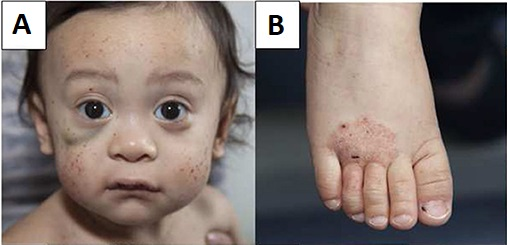- Definition: genetic condition characterized by impaired function of T cells and thrombocytopenia
- Epidemiology: occurs primarily in males
- Etiology: mutated WAS gene (X-linked recessive inheritance)
- Mechanism
- Genetic Defect: X-linked recessive mutation in the WAS gene.
- Protein Defect: Absent or dysfunctional WASP protein in hematopoietic cells.
- Core Mechanism: Impaired actin cytoskeleton rearrangement. This affects cell motility, adhesion, and signaling.
- Consequences:
- Platelets: Defective formation from megakaryocytes → Microthrombocytopenia (small platelets, low count) → Bleeding, petechiae.
- T-cells: Unable to form a proper immunological synapse → Defective T-cell function → Eczema, opportunistic infections.
- The T-cell defect in WAS causes a skewing towards a Th2 phenotype. Th2 skew (via IL-4) leads to ↑ IgE.
- B-cells: Poor T-cell help leads to failed response to polysaccharide antigens → Recurrent sinopulmonary infections (encapsulated bacteria).
- Cause ↓ IgM
- Clinical Presentation (Classic Triad - WATER)
- Wiskott-Aldrich
- Thrombocytopenia: Characterized by small platelets (↓ MPV). Leads to petechiae, purpura, epistaxis, hematemesis.
- Eczema: Severe, atopic dermatitis-like rash, often starting in infancy.
- Recurrent infections: Due to immunodeficiency.
- Otitis media, pneumonia, sinusitis (encapsulated bacteria like S. pneumo, H. influenzae).
- Opportunistic infections (e.g., Pneumocystis jirovecii).
- Typically presents in a male infant.
Mnemonic
Purpura and eczema are like you’re bit by a WASp.
- Diagnostics
- CBC: ↓ Platelet count, low mean platelet volume (microthrombocytopenia).
- Serum Immunoglobulins:
- ↓ or normal IgM
- ↑ IgA
- ↑ IgE
- Normal/↓ IgG levels over time.
- Flow cytometry: Can show absent or reduced WASp protein in leukocytes.
- Definitive Dx: Genetic testing for WAS gene mutation.
- Complications & Prognosis
- High risk of developing autoimmune disorders (e.g., autoimmune hemolytic anemia, vasculitis).
- High risk of malignancy, especially B-cell lymphoma (e.g., EBV-associated) and leukemia.
- Treatment
- Supportive care: Prophylactic antibiotics, IVIG replacement therapy.
- Platelet transfusions for severe bleeding.
- Definitive Tx: Hematopoietic stem cell transplantation (HSCT) is the only curative option.
